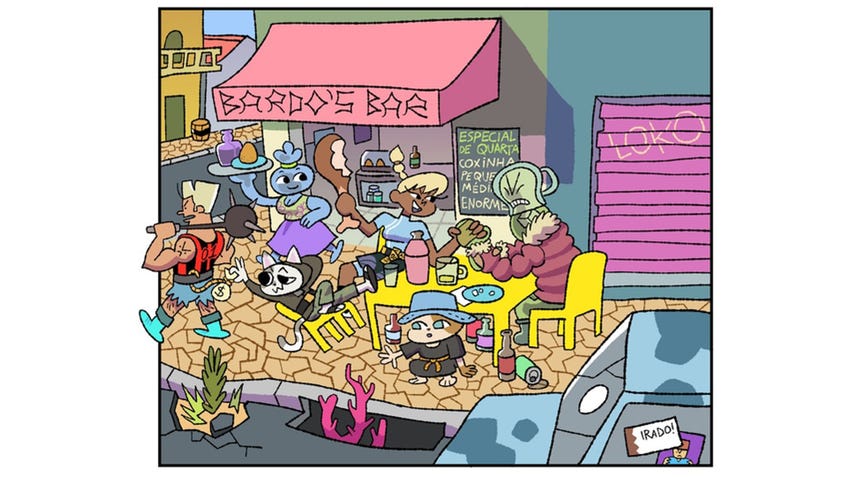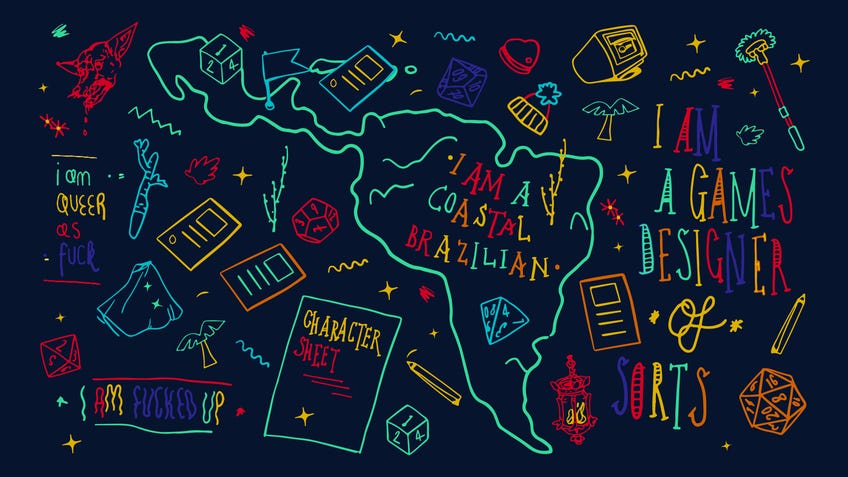‘Games mean community’: LATAM Breakout throws a much-needed spotlight on the tabletop RPG designers of Sudamerica
Five games by five designers that capture the real Global South, in their own words.
Latin America is a diverse place full of always compelling but often tragic history. It’s a part of the world not often thought of unless an American or European needs exotic women, barbarous men or monstrous queer folk. LATAM Breakout is a Kickstarter endeavour by SoulMuppet Publishing that aims to shine the spotlight on real Latines and their artistic role-playing visions.
“Lovingly, they called us the only aware gringos,” says Matt Sanders, one of the SoulMuppet team members I talked to. The other is Zach Cox. Together they are two of a whopping three contributors for the LATAM Breakout project not from the Global South. Both men are humble, pushing the conversation towards the project’s five designers and their fantastic RPGs. Cox tells me that “the brazen injection of originality of all these projects is so fantastic - I feel like most of the people I usually work with all started with black-and-white dungeon crawling”.
Cox speaks the truth here. These creators’ contributions compose a beautiful vision of vibrant, hopeful aesthetics into the wide world of RPGs. There is an identity among these designers connected through scarcity and scrappiness. Every one of these designers says to me, nearly word for word, the exact same thing: “This is the game I’ve always wanted to make.”
Mayflies
Design by Rachi, Art by Stephanie Arcas

“I view myself as a bridge.”
Rachi is incredibly humble in their description of themself and their project Mayflies. Their design is based around community. They describe Mayflies as a game “in the vein of things like OSR [Old School Renaissance, a style of RPGs noted for its lack of die rolls unless things go very badly], except you’re not adventuring to get rich, but to better your community.” Every word out of Rachi oozes this positivity and warmth - not just for themselves, but for the communities they are a part of.
“I am a game designer of sorts.”
In Rachi’s words, LATAM Breakout “is this wonderful opportunity for this whole generation of LATAM designers to come to light and be recognised”. This sentiment recurs among the designers: the idea that Breakout is a project not just for the personal benefit of these designers but as a socio-political message to the world at large. One that centres community and the experience of adventuring for reason beyond experience points.
“It’s important to me because it lets me explore an anti-capitalist view on a genre I love.”
Brave Zenith
Design by Giuliano Roverato, Art by Alex Damaceno and Silva João

“Playing RPGs in Brazil, for me, felt like picking through the ruins of a lost world.”
Roverato, a self-described “token white guy”, tells me that he “used to look through the closet to take peeks at my Brother’s Vampire [The Masquerade] books”. Roverato sees the world through a unique gaze inspired by the fixation with Vampire that the Southern Cone once had decades ago. His mind is on the nature of RPGs in his home, the ways in which manuals were either available in English or a butchered Portuguese. His game Brave Zenith is an homage to the realities of playing RPGs in a world that’s in and of itself post-cataclysm.
“I am a coastal Brazilian.”
Brave Zenith imagines RPGs inspired not by Tolkien, but by anime, scarcity and the intuitive nature of engaging a world after an apocalypse. This is a world where knowing what an orc is is irrelevant; all that matters is that shields are satellite dishes and you can be a cat-person. Through this, players new to RPGs can intuit the way the world itself works. This is a place for the uninitiated to explore a game world without precedent or expectations. “We don’t have the same pre-conceptions on things in RPGs,” Roverato says.
“This is the dream I want for Brazilian RPGs.”
Ultra Y Eterna
Design by Luna Petra G., Art by Elias, Alejandro Jota and Indignoir

“I am fucked up.”
“It doesn’t mean anything,” Petra G. says of the title of her game Ultra Y Eterna. “It’s this portmanteau of words I thought would be cool.” Ultra Y Eterna takes inspiration from a comic about a metaphorical scuba diver and the Junta in Argentina, a punk piece of Argentinean art that Petra. G is boldly borrowing from. Her work takes on a similar worldview, much like the designer herself. A self-described stirrer of shit, Petra G. and the creator of El Eternauta, Héctor Germán Oesterheld, both emanate a certain amount of bardo, the kind of guts it takes to set her game in an active junta.
“You go into a portal to save your city from imperialist devils.”
Ultra Y Eterna takes inspiration from the Shin Megami Tensei series of video games (better known in the west for its spin-off Persona 5) and works off of the skeleton of the Resistance RPG system, most well-known for its presence in Heart and Spire. Players take on the roles of hell-divers trying to investigate a giant portal to Hell formed from the aftermath of a “Super Operation Condor,” but the catch is that “there is no Doom Guy, only normal guys”. Ultra Y Eterna promises the experience of helping out your community by literally going through Hell.
“I love the idea of some poor American bastard reading my game and being horrified.”
Cantrip
Design by Misha Panarin, Art by Celeste Cruz

“Games to me mean, first of all, community.”
Community serves as a catch-all for Panarin, who also has great pride in their and others’ work in LATAM Breakout. They describe it as “an amazing opportunity, not just for us as designers, but also for players and our growing community”. Their game Cantrip revels in the creation of a school of witches and explores their hijinks.
“I am a proud communist sudaca.”
“Cantrip extensively rejects Harry Potter and is also a very queer game,” Panarin says of their ode to witches both real and fictional, providing a setting where anyone can be a witch and in which the principal idea is escape. The system itself supports an egalitarian bent, with no game master behind the screen - this is a story that all players work together to see through.
“It allows me to express a lot of the things I love all at once.”
here, there, be monsters!
Design by wendi yu, Art by Lino Arruda

“I don’t remember who said it, but it was described as ‘Yes, Kink at Pride: The Game.’"
wendi yu talks about her game here, there, be monsters! the way one would talk about a prized heirloom, and it truly is. The game has players inhabit a world in which monsters and their allies rebel against those who would impose normalcy onto them and the rest of the world. yu is rather on the nose with her own description of the work and herself: “I’m a trans woman from Brazil, and I view myself as a monster that would be hunted. I’m not normal, and it’s not worth it to be normal.” here, there, be monsters! is all about embracing this abnormality and demanding that the world moves over.
“I am queer as fuck.”
In the game, your foes vary from forces similar to the Men in Black to the SCP Foundation, but chief among them are “hetero-normative Neo-Nazi cultists, which you can punch, a lot”. yu’s work is an experience that demands of its player the admiration of the strange and the desire to reject any kind of societal expectation, whether it be for monsters, gender or otherwise.
“This is a way to cherish and praise monsters, and to accept and take pride in our own monstrosity.”

